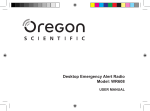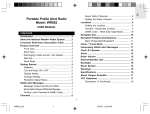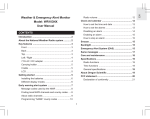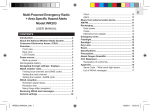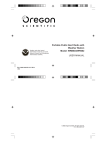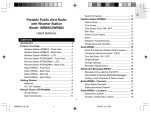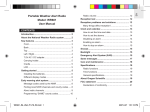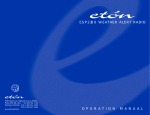Download Oregon WR606 User's Manual
Transcript
BACK VIEW 1 2 3 4 5 2. Radio status mode To switch between the radio status mode displays, press NOAA. 6 ICON A channel has been found. The sensor cannot be found. 7 8 USER MANUAL EN Thank you for selecting the Desktop Emergency Weather Station (WR606). This device operates on the same radio frequencies used by the National Weather Radio (NWR) and can send you NOAA alert messages to warn you about weather and other environmental dangers. This weather station is constructed of durable materials and has a reception range of up to 50 miles (64 km). It is also equipped with weather information display, digital clock and daily alarm. Keep this manual handy as you use your new product. It contains practical step-by-step instructions, as well as technical specifications and warnings you should know. ABOUT THE NATIONAL WEATHER RADIO SYSTEM The National Weather Service (NWS) is an agency within the National Oceanic & Atmospheric Administration (NOAA) that operates a nationwide network of radio stations known as the NOAA Weather Radio (NWR). The NWR radio system broadcasts warning information for all types of hazards, both natural and technological. Working in conjunction with the Emergency Alert System (EAS), NWR is an all-in-one hazards radio network and is considered to be the single source of all comprehensive weather and emergency information. 1. 2. 3. 4. 5. 6. 7. 8. NOAA: Press to switch between NOAA On / Standby / Mute / Off modes; press and hold to turn On / Off NOAA display MSG: Press to switch between NOAA alert messages; press and hold to activate / deactivate keypad lock MEM: Press to switch between the current, maximum and minimum temperature or humidity reading; press and hold to clear all maximum / minimum records CH: Press to switch between temperature and humidity display; press and hold to enable auto-scan of remote outdoor sensor channels PRESSURE: Press to select the barometric pressure unit (mb and inHg); press and hold to set the altitude compensation range for barometric reading : Press to adjust the altitude when setting the altitude compensation range RESET: Press to reset the unit to default value °C / °F: Switch to select the temperature unit GETTING STARTED - MAIN UNIT ADAPTOR AND BATTERIES You must use the AC/DC adaptor as the main source of power supply. Make sure the adaptor is not obstructed and the adaptor socket is easily accessible to the unit. NOTE Leaving the unit in NOAA ON mode will consume substantially more power. To save power, set the unit to NOAA Standby when you are not listening to radio broadcasts. CHANGE SETTINGS To change clock, alarm, channel and location settings: 1. Press and hold MENU for 2 seconds to enter setting mode. 2. Press or to scroll through the setting options (Set Alarm / Set Clock / Set Channel / Set Location) and press MENU to select the desired one. one. 3. Use or to change a setting, then press MENU to confirm and move onto the next one. 4. Press EXIT to leave the setting mode at any time. NOTE To reach a number quickly, press and hold or . This product complies with the Consumer Electronics Association (CEA) testing standards. Batteries serve as back-up only. Use 3 pieces of AA (UM-3) 1.5V batteries. Insert batteries before first use, matching the polarity. Press RESET after each battery change. NOTE When the unit is set to NOAA ON, Standby or Mute, it will continually search for NOAA signal. GETTING STARTED - REMOTE OUTDOOR SENSOR 1 2 3 4 5 6 7 8 9 10 2 11 NOAA ALERT MESSAGES SET THE LOCATION When the NWR airs urgent warnings, a digital code known as Specific Area Message Encoding (SAME) is included as part of the message. This coding system contains specific information including the localized geographical area affected and the expiration time of the message. The WR606 retrieves and interprets SAME code messages and alerts the user. When SAME codes for a specific region have been entered into the unit, the unit alerts the user to relevant warning information for the specified region. Once alerted, a voice broadcast can be heard. You need to set the location so that you can receive weather and environmental information for an area that is relevant to you. FIND LOCAL CHANNELS AND SAME CODES The codes are subject to change. Therefore, to ensure successful operation you must obtain the most appropriate, up-to-date NWR radio channels and SAME codes for a specific county or region, from the contact details listed below. To contact the NWS by telephone: 1. Phone 1-888-NWR-SAME (1-888-697-7263). 2. Follow prompts through a simple voice menu. 1 4 3 5 COUNTY SAME# NWR TRANSMITTER FREQ. MHZ CALL Beaverhead 030001 Butte, MT 162.550 WXL79 100 Beaverhead 030001 Dillon, MT 162.475 WNG638 150 Big Hom 030003 Billings, MT 162.550 WXL27 300 Blaine 030005 Havre, MT 162.400 WXL53 300 Blaine 030005 Billingd, MT 162.475 WWG85 100 Broadwater 030007 Helena, MT 162.400 WXK66 1000 Carbon 030009 Billings, MT 162.550 WXL27 300 Carter 030011 Baker, MT 162.550 WXK57 300 Cascade 030013 Great Falls MT 162.550 WXJ43 300 Chouteau 030015 Miles Hill, MT 162.500 WWG84 300 12 13 LOCATION MEANING in outdoor temperature area Remote outdoor sensor batteries low in NOAA area 14 15 16 1. 2. 3. 4. 5. 6. 7. 8. 9. 10. 11. 12. 13. 14. 15. 16. Remote outdoor sensor reception icon Barometric pressure Outdoor temperature and humidity Weather forecast Indoor temperature and humidity Alarm icon Radio channel Clock / Alarm / Calendar / NOAA alert messages / Setting options display MENU: Press to switch between clock, calendar, alarm 1 and 2 displays; press and hold to enter setting mode; confirm setting value EXIT: Press to exit any setting mode or return to clock display / : Increase / decrease settings; increase / decrease volume; enable / disable alarm 1 or 2 SNOOZE / LIGHT: Press to activate 8-minute snooze or backlight for 5 seconds; press and hold to disable snooze function Antenna External antenna jack External speaker jack AC / DC adaptor jack WR606 EN UM R2.indd 1 2. Wall mount hole 3. Battery compartment Main unit batteries low 4. RESET hole 5. CHANNEL switch TURN THE NOAA RADIO ON / OFF To turn the NOAA radio ON / OFF, press and hold 1. LED status indicator NOAA. When the unit is first connected or reset, it will immediately enter the clock / language setting mode (see Change Settings section). It is advisable to set your preferred language English (E), French (F) or Spanish (S) at this time, so you can read the NOAA alert messages. DISPLAY MODES There are 2 display modes: 1. Clock mode To switch between the clock mode displays, press MENU. WATTS To set the location: 1. Navigate to “Set Location” setting mode as shown in the Change Settings section. 2. Select where you want to store the location e.g. C1. 3. Select the 6-digit number e.g. “000000”. (“----“ means the location is disabled.) 4. Select “Name” or “FIPS”. REMARKS If you select “Name” you can select first the State and then the County of your chosen location, then press EXIT. (If you wish to receive State-wide NOAA messages, press EXIT once you have selected the State.) • If you select “FIPS” you need to enter the 6-digit SAME code of your chosen location and then press EXIT (see Find Local Channels and SAME Codes section for how to obtain a SAME code). NOTE If at step 2 you select “C0:All” you will receive all warnings within the unit’s reception range. This may result in giving you information for regions that are not relevant. The regions can be as large as 5,000 square miles (13 sq km). If you select “CO:----” you will disable the ALL option and will only receive warnings from specified local areas. NOTE Once the location name is selected, the corresponding FIPS code will be set into the memory.You cannot convert the code back to the location name.(FIPS is the Federal Information Processing System number assigned to each State, or open waters in or around the US. The SAME code comprises of numbers generated by the FIPS system.) ACTIVATE / DEACTIVATE LOCATION You can activate / deactivate 1, some, or all of your stored locations. When a location is activated, the 6-digit SAME code can be viewed in your stored locations display. 1 Northwest 2 North Central 3 Northeast 4 West Central 5 Central 6 East Central 7 Southwest 8 South Central 9 Southeast 1 2 3 4 5 6 7 8 9 RECEIVING NOAA ALERT MESSAGES To receive NOAA alert message, press NOAA to set the unit to one of the following options: ]: The unit is ON and voice messages • ON [ can be heard continuously. • Standby [ ]: The unit is in Standby and will switch to ON when NOAA alert message is received. • Mute [ ]: The unit is in Standby with the sound turned OFF. NOAA alert messages can be viewed but not heard. Switch the unit ON to hear messages. • OFF: The unit is turned OFF and will not respond to NOAA alert messages. Turning the unit off by setting it to Standby, Mute or OFF will help to save power. RECEPTION TEST N NOTE Many counties have been subdivided into as many as 9 smaller subsections. The numbers 1-9 in the far left column of the SAME code identifies specific subsections of a county. If a county has not been subdivided, the first digit of the SAME code will be 0. When a location is deactivated, “----” can be viewed in your stored locations display. The NWR radio channels work in the same way as a regular radio channel. All of the NWR transmission stations operate on 1 of 7 frequencies. CORRESPONDING RADIO FREQUENCY To switch between activated or deactivated location status: 1 162.400 MHz 2 162.425 MHz 3 162.450 MHz 4 162.475 MHz SAME CODE – WHAT EACH DIGIT MEANS NOTE Use alkaline batteries for longer usage and consumer grade lithium batteries in temperatures below freezing. 5 162.500 MHz 6 162.525 MHz A SAME code is broken into 3 sets of numbers.The example below is the code for the northeast sub-section of Cochise County. 7 162.550 MHz A Auto – the unit will tune to the strongest RF signal available The unit labels each frequency as a channel (1-7 or Auto). Once the radio frequency for a region has been selected the unit will receive voice and code information from that station. The channel number in use can be viewed on the top left-hand corner of the LCD. The fact that you can get clear voice reception does not guarantee that an emergency alert will trigger your unit’s alert tone. To test actual reception, your unit must receive a test or emergency alert signal broadcast. The National Weather Service (NWS) broadcasts a test alert every week on Wednesday between 11AM and 12PM (noon). To find out the specific test schedule in your area, contact your local National Oceanic and Atmospheric Administration (NOAA) or National Weather Service (NWR) office. These offices are usually listed in the telephone book under “US Government”. REMEMBER For your system to be effective, you must place the unit in a location where it can receive an emergency alert signal, you can hear its siren, and see its flashing indicator lights. ABOUT RADIO CHANNELS To set up the remote outdoor sensor: 1. Open the battery compartment and insert batteries, matching the polarity. 2. Select a channel then press RESET. 3. Close the battery door. 4. Place the remote outdoor sensor within 30 m (98 ft) from the main unit. The remote outdoor sensor reception icon will show the following status: A county can be subdivided as follows: NOTE If you do not set a location, the unit will use the default setting “CO:All” for all counties. CHANNEL To search for a remote outdoor sensor: Press MEM + CH. NOTE If the county sub-section code is stated as 0, then that county is not sub-divided and all alerts for that county will be received. To receive all of the alerts for a given county, insert 0 into the county sub-section. You can choose the location by either the state and county name, or FIPS code. Up to 9 locations (1-9) can be stored. The remote outdoor sensor can collect data from up to 3 channels. SENSOR DATA TRANSMISSION County sub-section code: The last digit on the left is for county sub-section coding. A county may be subdivided into nine sub-sections; each number between (1-9) represents a specific county sub-section. • Example of the first 10 county radio channels and SAME codes for Montana. No NOAA alert message has been received for 10 days. Current selected channel signal is strong PRODUCT OVERVIEW To change the radio channel, navigate to “Set Channel” setting mode and select the desired Channel, as shown in the Change Settings section. Current selected channel signal is weak DESCRIPTION No NOAA alert message has been received for 10 days. Current selected channel signal is weak CONSUMER ELECTRONICS ASSOC. (CEA) TIP The transmission range may vary depending on many factors. You may need to experiment with various locations to get the best results. Current selected channel signal is strong RECEPTION SIGNAL STATUS ICON SET THE RADIO CHANNEL To obtain NWS radio channels and SAME codes on the internet: 1. Locate www.nws.noaa.gov/nwr/indexnw.htm 2. Click the State for which information is needed. For example, clicking on “Montana” will give a list of information relevant to the State of Montana including the names of counties, SAME codes, NWR transmitter locations, the frequency of the transmitter, the strength of the signal in WATTS, and any remarks as applicable. To check the status of the reception signal, look at the reception icon on the display. A nationwide network, the NWR consists of more than 900 stations in 50 states, Puerto Rico, the US Virgin Islands and US Pacific Territories. Broadcasts are designed to meet local needs. Routine programming is repeated every few minutes and consists of local forecast, regional conditions and marine forecasts. Additional information, including river stages and climatic data, is also provided. During emergencies, these routine broadcasts are interrupted to report specific warnings. FRONT VIEW State code: Moving towards the left, the next 2 digits are for state coding. Each of the 50 U.S. States has their own 2digit code. Main unit is searching for sensor(s). WR606 Desktop Emergency Weather Station INTRODUCTION 000 into the county section. DESCRIPTION 1. Navigate to “Set Location” setting mode as shown in the Change Settings section. 2. Select a stored location e.g. C4 and press MENU. Then when “000000” or “----” is blinking, press to activate or deactivate it and press EXIT to or confirm the setting. 3 04 003 Code for Cochise County Code for Arizona Code for northeast sub-section of Cochise County State-county code: The 3 digits on the right are for state county coding. Each county within a state has an independent 3-digit code. NOTE To receive all of the alerts for a given state, insert RECEPTION PROBLEMS AND SOLUTIONS Forests, deserts, and hills / mountains tend to greatly reduce reception. Reception in cities may be reduced due to steel and concrete, while higher elevations will enhance the signal. Reception can vary from room to room. Moving even a few feet can enhance signal reception. RECOMMENDATION Place your weather station near a window, away from other electronic equipment, and on an upper level of your house. INTERPRETING NOAA ALERT MESSAGES This product is equipped to receive all required NOAA and Emergency Alert System (EAS) events. When an EAS event is sent by the NWS, any 1 of the following NOAA alert messages will scroll across your weather station display: “WARNING”, “WATCH”, or “ADVISORY”. The unit can store up to 8 NOAA alert messages. Additionally, to help you check that your unit is set-up and working properly, your local NOAA will release a Test NOAA message every Wednesday between 10am and noon, local time. To receive the Test message make sure that your unit is set to NOAA ON, NOAA Standby or NOAA Mute mode, that a Channel has been selected and a SAME code programmed in. If you have any questions regarding alarm tests or to verify if a test was 5/27/08 3:02:35 PM conducted, contact the programming office of your local NOAA Weather Radio station. Required Monthly Test ADVISORY To view NOAA alert messages, press MSG. Required Weekly Test ADVISORY For more information on how to interpret the NOAA alert messages, please refer to the list of National Events and Messages below: Special Marine Warning WARNING Special Weather Statement ADVISORY TEMPERATURE, HUMIDITY AND PRESSURE TREND Shelter In-Place Warning WARNING The temperature, humidity and pressure trend icons are based on recent remote outdoor sensor readings. • Do not dispose old batteries as unsorted municipal waste. Collection of such waste separately for special treatment is necessary. The following information is not to be used as contact for support or sales. Please call our customer service number (listed on our website at www.oregonscientific.com or on the warranty card for this product) for all inquiries instead. Severe Thunderstorm Watch WATCH WARNING NOTE The technical specifications for this product and the contents of the user manual are subject to change without notice. ADVISORY Avalanche Watch WATCH Avalanche Warning WARNING Severe Thunderstorm Warning Biological Hazard Warning WARNING Severe Weather Statement ADVISORY Boil Water Warning WARNING Tornado Watch WATCH Blizzard Warning WARNING 911 Telephone Outage Emergency ADVISORY Child Abduction Emergency ADVISORY Tornado Warning WARNING Civil Danger Warning WARNING Tropical Storm Watch WATCH Civil Emergency Message WARNING Tropical Storm Warning WARNING Coastal Flood Watch WATCH Tsunami Watch WATCH Tsunami Warning WARNING Volcano Warning WARNING WARNING Contaminated Water Warning WARNING Transmitter Backup On ADVISORY Dam Watch WATCH Transmitter Carrier Off ADVISORY Dam Break Warning WARNING Transmitter Carrier On ADVISORY Transmitter Primary On ADVISORY Wild Fire Watch WATCH Wild Fire Warning WARNING Winter Storm Watch WATCH Winter Storm Warning WARNING Unrecognized Watch WATCH Unrecognized Emergency ADVISORY Unrecognized Statement ADVISORY Unrecognized Warning WARNING Contagious Disease Warning WARNING Practice / Demo ADVISORY Dust Storm Warning Emergency Action Notification WARNING WARNING Emergency Action Termination ADVISORY Earthquake Warning WARNING Immediate Evacuation WARNING Evacuation Watch WATCH Food Contamination Warning WARNING Flash Flood Watch WATCH Flash Flood Statement ADVISORY BAROMETER Flash Flood Warning WARNING Barometer readings from the past 24 hours are stored by the main unit and used to provide weather forecast. Flood Watch WATCH Flood Statement ADVISORY Flood Warning WARNING SET ALTITUDE Fire Warning WARNING Flash Freeze Warning WARNING Freeze Warning WARNING Hurricane Statement ADVISORY To ensure barometric readings are reliable set the altitude to reflect distance from sea level at your position. 1. Press and hold PRESSURE for 2 seconds. 2. Use to set the altitude in 10 m (33 ft) increments from -100 m (-328 ft) to 2500 m (8202 ft). 3. Press PRESSURE to confirm. NOTE The 4 “Unrecognized” messages above will appear when a new NOAA alert message is created and broadcasted. The unit will not be able to recognize the message as it is not in the software database. To select barometer measurement unit: Press PRESSURE to toggle between mb and inHg. Hazardous Materials Warning WARNING NOTE The maximum operating altitude for the barometer and weather forecast is 2500m (8202 ft). Hurricane Watch WATCH WEATHER FORECAST Hurricane Warning WARNING High Wind Watch WATCH This product forecasts the next 12 to 24 hours of weather within a 30-50 km (19-31 mile) radius based on barometric pressure trend readings. High Wind Warning WARNING Iceberg Warning RISING STEADY FALLING ICE WARNING If the channel 1 remote outdoor sensor falls between 3°C to –2°C (37°F to 28°F), flashes to warn you that the temperature is approaching freezing. Digital PLL tuning for 7 NOAA channels CLOCK AND CALENDAR SAME code setting options 9 independent settings or ALL counties To set the time and date, navigate to “Set Clock” setting mode as shown in the Change Settings section. The order of the settings is: • 12 / 24 hour format, hour, minute, month / day format, year, month, day and day of the week language (English, French or Spanish). NOTE The day of the week language you select will also be used for the NOAA alert messages. The unit has 2 alarms (alarm 1 and 2). They can be used together or independently. Alarms 1 and 2 have different sounds so that you can differentiate them. The alarm will sound for 1 minute unless it is disabled. To set the alarm: Navigate to “Set Alarm” setting mode as shown in the Change Settings section. The order of the settings is: alarm 1 or 2, hour and minute. To silence the alarm: • Press SNOOZE / LIGHT to silence it for 8 minutes. • Press and hold SNOOZE / LIGHT, or press any button except SNOOZE / LIGHT, to turn the alarm OFF and activate it again at the same time the next day. To enable or disable the alarm: • Press MENU until you reach alarm 1 or 2 display. • Press or to enable or disable the alarm. The alarm icon or will appear on the clock display when the alarm is enabled. NOAA RADIO VOLUME or to adjust the volWhen NOAA radio is On, press ume. (Maximum volume is 7 / minimum volume is 1.) EXTERNAL ANTENNA JACK There are chances that signal reception may experience interference. The use of the RCA jack is an optional choice to ensure clear and unobstructed signal reception. 7 adjustment levels TIME FUNCTIONS Clock 12 / 24 hr format Calendar Day of the week language in English, French or Spanish Daily alarm 2 x 1-minute duration alarms Snooze 8-minute snooze DD: MM or MM: DD format Oregon Scientific, Inc. 19861 SW 95th Ave.,Tualatin, Oregon 97062 USA Telephone No.: 1-800-853-8883 Product No.: WR606 Product Name: Desktop Emergency Weather Station Manufacturer: IDT Technology Limited Block C, 9/F, Kaiser Estate, Phase 1,41 Man Yue St., Hung Hom, Kowloon, Hong Kong is in conformity with Part 15 of the FCC Rules. Operation is subject to the following two conditions: 1) This device may not cause harmful interference. 2) This device must accept any interference received, including interference that may cause undesired operation. GENERAL SPECIFICATIONS Battery type 3 x UM-3 or AA size 1.5V (optional only) AC / DC adaptor 7.5V Unit dimensions 204 x 55.6 x 100 mm (8 x 2.19 x 3.937 in) Unit weight 300.6 g (10.6 oz) without battery Operating temperature 23°F to 122°F (-5°C to 50°C) Temperature resolution 0.2°F (0.1°C) REMOTE OUTDOOR SENSOR (THGN132N) LxWxH 50 x 22 x 96 mm (1.97 x 0.87 x 3.78 in) Weight 62 g (2.22 oz) without battery Transmission range 30 m (98 ft) unobstructed Signal frequency 433MHz Temperature range -4°F to 140°F (-20°C to 60°C) Humidity range 25% - 95% Power 1 x UM-3 (AA) 1.5V battery FCC STATEMENT RESET This device complies with Part 15 of the FCC Rules. Operation is subject to the following two conditions: (1) This device may not cause harmful interference, and (2) This device must accept any interference received, including interference that may cause undesired operation. Industrial Fire Warning WARNING Partially Cloudy Local Area Emergency ADVISORY • Do not subject the unit to excessive force, shock, dust, temperature or humidity. Cloudy • Do not cover the ventilation holes with any items such as newspapers, curtains etc. Law Enforcement Warning WARNING Land Slide Warning WARNING National Audible Test ADVISORY National Information Center ADVISORY Network Notification ADVISORY National Periodic Test ADVISORY National Silent Test ADVISORY Nuclear Power Plant Warning WARNING To auto-scan between remote outdoor sensors: Press and hold CH for 2 seconds. • Images shown in this manual may differ from the actual display. Power Outage Advisory ADVISORY Radiological Hazard Warning To end auto-scan: Press CH or MEM. • When disposing of this product, ensure it is collected separately for special treatment. WARNING To toggle between current, minimum and maximum • Placement of this product on certain types of wood may result in damage to its finish for which Oregon To view different remote outdoor sensor temperature readings: Press CH. Volume Press SNOOZE / LIGHT to activate the backlight. PRECAUTIONS To toggle temperature unit: Switch °C / °F. Address: BACKLIGHT Sunny TEMPERATURE AND HUMIDITY 50 miles (64 km) EXTERNAL SPEAKER JACK The external speaker jack allows you to connect the unit with an external speaker system so that broadcasts can be announced in public areas i.e. schools, hotels, train stations etc. Name: Address: RF reception range ALARM We declare that the product Channels WARNING Rainy SPECIFICATIONS RADIO FUNCTIONS DESCRIPTION ICON • Please note that some units are equipped with a battery safety strip. Remove the strip from the battery compartment before first use. NOTE The warning will automatically stop if the temperature goes outside the ice-warning range. The RESET button is located in the main unit battery compartment. Press RESET when you change the batteries and whenever performance is not behaving as expected. WR606 EN UM R2.indd 2 Consult the dealer or an experienced radio / TV technician for help. DECLARATION OF CONFORMITY Administrative Message WARNING • • The contents of this manual may not be reproduced without the permission of the manufacturer. MESSAGE Chemical Hazard Warning Scientific will not be responsible. Consult the furniture manufacturer's care instructions for information. To clear the records: Press and hold MEM for 2 seconds. NATURE OF ACTIVATION Coastal Flood Warning records for the selected remote outdoor sensor: Press MEM repeatedly. • Do not immerse the unit in water. If you spill liquid over it, dry it immediately with a soft, lint-free cloth. • Do not clean the unit with abrasive or corrosive materials. • Do not tamper with the unit’s internal components. This invalidates the warranty. • Only use fresh batteries. Do not mix new and old batteries. WARNING Changes or modifications not expressly approved by the party responsible for compliance could void the user’s authority to operate the equipment. NOTE This equipment has been tested and found to comply with the limits for a Class B digital device, pursuant to Part 15 of the FCC Rules. These limits are designed to provide reasonable protection against harmful interference in a residential installation. This equipment generates, uses and can radiate radio frequency energy and, if not installed and used in accordance with the instructions, may cause harmful interference to radio communications. However, there is no guarantee that interference will not occur in a particular installation. If this equipment does cause harmful interference to radio or television reception, which can be determined by turning the equipment off and on, the user is encouraged to try to correct the interference by one or more of the following measures: • Reorient or relocate the receiving antenna. • Increase the separation between the equipment and receiver. • Connect the equipment into an outlet on a circuit different from that to which the receiver is connected. 086L005565-0XX 5/27/08 3:02:48 PM


